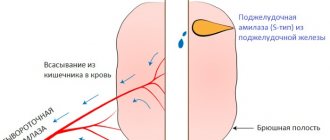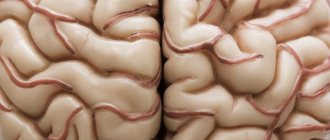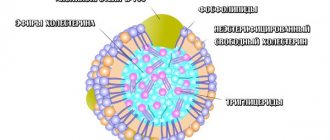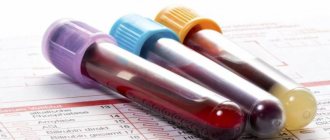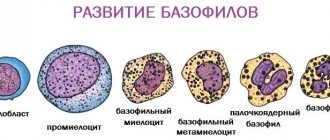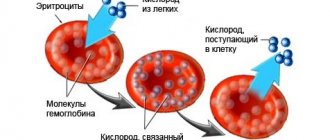Elevated alpha-amylase in the blood - main symptoms: Pain in the right hypochondrium Diarrhea Weakness Nausea
Amylase is an important digestive enzyme that the body produces on its own. It is involved in the breakdown of carbohydrates. Elevated amylase signals an existing pathology. Timely treatment will help to successfully cope with the disease and prevent complications.
Timely consultation with a doctor and diagnosis will help to timely determine the cause of deviations and prescribe effective treatment
Functions of alpha-amylase in the body
The main task of alpha-amylase is the digestion of complex compounds such as starch. However, the enzyme itself is not able to perform it; alpha-amylase is only a catalyst for natural biochemical processes. The essence of the enzyme’s action is to identify energy deficiency in the gastrointestinal tract. A normal concentration of a substance indicates a balanced metabolism, a deviation from the norm in any direction indicates a potential disease.
Amylase in a biochemical blood test indicates its concentration, first of all, about the condition of the pancreas and only then - the salivary glands and other organs of the digestive system. In this regard, two types of enzyme are distinguished: salivary amylase and pancreatic amylase. The main one is pancreatic amylase, which is synthesized by the pancreas and is part of pancreatic juice, taking part in the breakdown of complex substances.
Why is the rate high?
A marked increase in pancreatic amylase in the blood is often observed in the acute stage of pancreatitis (more than 90% of the activity of total amylase is detected). In some patients, a pronounced increase in the level of the enzyme does not occur, since the producing cells die during destructive processes.
The level of amylase cannot be used to judge the nature and extent of organic changes in the structure of the pancreas. In chronic pancreatitis, a jump in P-amylase levels is observed, after which the levels return to normal.
High enzyme activity is observed in people suffering from diabetes, during ketoacidosis and at the stage of decompensation, with pancreatic injuries or tumor diseases of the gland. In addition to the listed disorders, an increase in amylase levels can be caused by:
- peritonitis;
- inflammatory process of the appendix;
- ulcerative defect of the wall of the abdominal organ;
- inflammation of the gallbladder;
- intestinal obstruction;
- rupture of an aortic aneurysm.
High levels of the enzyme or macroamylasemia occur when the enzyme interacts with certain blood albumins. Due to the formation of large complexes, the excess substance cannot be excreted by the kidneys and accumulates in the body.
Alpha-amylase levels in adults and children
The concentration of alpha-amylase in the blood of women and men is almost the same. The range of normal values is from 25 to 125 U/ml of blood. Age has almost no effect on normal enzyme levels: in the period from 25 to 60 years, the lower limit of normal increases to 30 units. Gestation can fluctuate by 10 units on either side of the normal level.
In children, the alpha-amylase level is presented in the table.
| Age | Norm in U/ml |
| Newborns | No more than 8 |
| Up to a year | 4,7-64,7 |
| Up to 5 years | 15,1-100,1 |
| Before 18 | 20,1-100,1 |
Facts about amylase
- Amylase is found in both plants and animals.
- Salivary amylase is also known as ptyalin. Humans have this enzyme in their saliva, but some mammals, such as horses, dogs and cats, do not.
- Enzyme production decreases with age. As we age, our bodies produce less amylase, lipase and protease. This means that the absorption of carbohydrates, fats and proteins may decline as we age.
- Enzymes play a key role in every function of the human body. These protein-based substances are involved in respiration, nutrition, digestion, kidney and liver function, reproduction and more.
- Dogs and cats can also benefit from digestive enzyme supplements.
What does amylase contain and how to use?
Natural dietary sources of amylase include fresh fruits and vegetables, as well as sprouted seeds, nuts, legumes and whole grains. Both short- and long-term sprouting helps the body regulate the activity of the amylase enzyme. It is necessary for the proper digestion of glucose, which is especially useful for diabetics. Royal jelly is also an excellent source.
Supplements contain amylase as part of a general digestive enzyme supplement that includes other key digestive enzymes. Be sure to look for a full spectrum enzyme blend for overall digestive benefits. Depending on your preferences, you can choose a supplement of vegetarian or animal origin.
We recommend considering the following amylase supplements:
- Natural Factors, Papaya Enzymes with Amylase and Bromelain, 120 Chewable Tablets
- American Health, Original Papaya Enzyme, 600 Chewable Tablets
- Enzymedica, Digest Basic, Essential Enzyme Formula, 90 Capsules
- Now Foods, Super Enzymes, 180 Capsules
- Top Doctor Digestive Enzymes 90 Vegetarian Capsules
Causes of increased alpha amylase
The enzyme level can be considered a kind of screening of the state of the digestive system. An increase in the concentration of pancreatic alpha amylase, first of all, indicates the development of pancreatitis. But besides this, the reasons for the increase in the concentration of pancreatic alpha-amylase can be: heart or kidney failure, diabetes mellitus, appendicitis, peritonitis, acute intestinal infections, pregnancy, intoxications of various etiologies, tumor growth, diabetes mellitus, cholelithiasis.
It is possible that, with manifest symptoms of pancreatitis, the enzyme level remains virtually unchanged. This is a poor prognostic sign, which indicates almost complete destruction of the organ.
Salivary amylase increases as a result of mumps, injury or infection of the salivary glands, pneumonia, lung tumors, tuberculosis, prostatitis, testicular cancer, adenoma, and postoperative conditions.
There are other reasons for increased alpha amylase in the blood: abdominal trauma, ectopic pregnancy, herpes, intestinal obstruction, taking certain medications, alcoholism. Increased fluctuations in enzyme levels are possible due to an unbalanced diet and stress.
Amylase during pregnancy
Amylase levels increase during ectopic pregnancy
There is a separate question about the level of alpha-amylase during ectopic (ectopic) pregnancy. If the fertilized egg has attached to the endometrium in the uterus, then amylase levels are no different from those before pregnancy. An increase or decrease in the concentration of the indicator may occur in the above conditions. If implantation of the fertilized egg occurs in the fallopian tube or ovary, the level of the indicator increases approximately 8 times. This is due to the fact that the fallopian tubes and ovaries begin to actively secrete this enzyme.
Indications for the study
Normally, a minimal amount of enzyme circulates in the bloodstream, which is due to the constant renewal of pancreas cells and salivary glands. When the pancreas is damaged, alpha-amylase in the blood increases sharply. The growth of the enzyme also occurs when there are disturbances in the functioning of the intestines, bronchi, ovaries, and skeletal muscles. Amylase is also synthesized there in small quantities.
A biochemical study is prescribed to confirm the diagnosis of acute or chronic pancreatitis, not to miss a pancreas tumor, and if it is detected, to monitor the result of therapy, to assess the condition of the bile ducts after removal of stones.
Analysis for amylase is important for: girdle pain in the abdomen, hyperthermia, lack of appetite, nausea with transition to uncontrollable vomiting.
Amylase level: analysis
Amylase - what is it? How to determine its level in the human body? The fact is that the pancreas, where this enzyme is produced, is very well supplied with blood. Normally, part of the enzyme (its minimum amount) enters the bloodstream. This hydrolase then passes through the kidneys and is excreted in the urine.
Blood alpha amylase - what is it? We'll talk about this in more detail below.
Preparing and conducting analysis
To determine the concentration of amylase, blood serum is needed, which is taken from a vein. For the most reliable data, a number of rules must be followed:
- last meal before the test 12 hours before;
- in the morning you can drink only clean water without gas;
- stop smoking in half an hour, in a day - exclude alcohol, fatty and fried foods;
- 5 days in advance, agree on taking medications with a doctor;
- on the eve of the test, minimize stressful situations and limit physical activity and active movement.
Increasing values
Amylase increased by a couple of units in a biochemical blood test does not cause the doctor any concern at all, if there are no alarming clinical manifestations. But when the coefficient jumps by 2–3 times, one can immediately conclude that pathological changes are present in the body.
They are easy to predict, because such a strong increase in the indicator is often combined with periodic pain in the epigastric region and a deterioration in general well-being. One of the most likely diseases that is accompanied by an excessive increase in serum amylase is pancreatitis or an inflammatory disease of the pancreas. It can occur in both acute and chronic forms.
Acute pancreatitis
A rapidly, one might say, rapidly developing pathology. The organ is affected by enzymes of its own production, a significant amount of which penetrates the serum, thereby creating a danger to the life and health of the patient. Numerous studies and observations show that the level of alpha-amylase in pancreatitis can increase 8 times. Its maximum concentration is determined 4 hours after the onset of the attack.
Normalization of the enzyme content in such cases occurs only after several days. The disease most often occurs in adults, and its development is not determined by gender or genetic characteristics. It should be noted that the risk group mainly includes people who abuse alcohol.
Chronic pancreatitis
Slowly but constantly progressive inflammation localized in the pancreas. With this pathology, amylase activity often increases up to 3–5 times. One of the negative concomitant aspects of the disease is that inflammatory processes in most cases are not eliminated even after neutralizing the factors that led to them.
Over time, the pancreas loses its ability to perform its functions. The disease in almost all cases is accompanied by pain in the pit of the stomach, which often moves to the hypochondrium (right or left), radiates to the back and often reaches the heart, simulating angina.
The process of formation and transport of amylase into blood serum
Other reasons
Less common causes that can lead to increased amylase concentrations are:
Urine analysis for diastase - what is it?
- Cyst, cancerous tumors of the pancreas or the formation of stones in it. This causes structural damage to the organ, which leads to compression of the glandular tissue. In this situation, the synthesis of alpha-amylase can increase to 200 U/l.
- Mumps (mumps or mumps) is a disease that primarily affects children aged 3–15 years. The pathology is infectious in nature, and its development is caused by a paramicrovirus. As a result, it affects the salivary gland located near the ear, leading to noticeable swelling in the area, as well as fever and pain.
- Peritonitis is an inflammatory process in the peritoneum, due to which the condition of the entire body is regarded as serious. This pathology has an irritating effect on the pancreas, which provokes its cells to synthesize an increased amount of amylase.
- Diabetes mellitus is a disease that pathologically changes metabolism, also negatively affecting carbohydrate metabolism. In this situation, the described enzyme is not completely wasted, as a result of which its level in the blood serum increases.
- Renal failure is a condition accompanied by partial or complete loss of the kidneys’ function to excrete or form urine. A violation of the body’s self-regulation develops, and much more enzyme is produced.
In addition, the reasons for determining an increased enzyme concentration in the LHC can sometimes be the following:
- alcohol poisoning;
- ectopic pregnancy;
- disordered eating;
- injuries in the abdominal area;
- intestinal obstruction;
- dysfunction of the salivary glands;
- gastroenteritis, cholecystitis;
- Epstein-Barr virus, macroamylasemia;
- perforation of the stomach, intestines;
- blockage of the pancreatic duct;
- exacerbation after surgery.
Reference! The influence of a certain number of hereditary factors can increase the content of amylase in the blood. They prevent the substance from being excreted into the urine, causing it to accumulate in the serum.
Surgery in the vast majority of cases leads to an increase in blood amylase.
Reasons for the decline
There is also a drop in the concentration of the compound. What's to blame?
Hepatitis
Viral liver inflammation is the main cause of low amylase in a blood test. Less common are toxic forms of the pathological process: medicinal and alcoholic varieties.
The symptoms of the condition are noticeable:
- Severe pain.
- Increased body temperature.
- Digestive disorders.
Treatment is carried out by a gastroenterologist or hepatologist. If there is one on staff at the hospital. Hepatoprotectors and special antivirals are prescribed to overcome the condition.
Pancreatic tumor
Cancer. As a result, there is a breakdown in the functioning of the entire organism, including the enzymatic system. The production of enzymes by altered tissues becomes impossible, which is manifested by a decrease in blood amylase levels.
The symptoms of the disorder are vague, although you can notice them:
- Pain in the left side of the abdomen.
- Nausea.
- Vomit.
- Total digestive disorder.
Restoration is carried out urgently. Under the supervision of an oncologist. Surgery, chemotherapy and radiation therapy are indicated. It all depends on the type of neoplasia (its histological structure).
What to do if pancreatic amylase is elevated
A significant increase in pancreatic amylase in the blood is an indication for hospitalization.
Prehospital measures are aimed at eliminating pain and suppressing the activity of pancreatic enzymes.
Painkillers: Baralgin, Analgin, Tramal.
To eliminate spasm: Papaverine, Halidor, No-Shpa.
Antispasmodic anticholinergics: Buscopan, Metacin.
Normalization of sphincter of Oddi tone: Duspatalin.
Inhibition of the activity of pancreatic enzymes: Kvamatel (famotidine).
Antihistamines, antiserotonin drugs that reduce edema: Tavegil, Suprastin, Dimedro, Peritol.
In severe forms of acute pancreatitis, measures are taken in the intensive care unit. To reduce enzymatic toxemia, Contrical or other proteolysis inhibitors are administered intravenously on the first day of the disease. Antibacterial therapy is prescribed.
After the acute situation subsides, pancreatic enzymes that do not contain bile are prescribed in an intermittent course for up to 3 months (2 weeks on, 10 days off): Pancreatin, Mezim-Forte, Creon, Pancitrate (1 tablet 3 times a day with meals) .
Diet to reduce pancreatic amylase
In the first 1-2-3 days of an acute condition - hunger.
Then the following are gradually introduced into the diet: - pureed porridge with water; - slimy pureed soups with water; - milk; - weak tea with crackers; - omelette; - cottage cheese; - low-mineralized water without gas, 50-100 ml 5-6 times a day: Slavyanovskaya, Essentuki No. 4, Borjomi, Naftusya.
From the 7th day the following is allowed: - vegetable and potato purees; — steam cutlets, boiled fish; - White bread; - baked apples, fruit purees.
During the recovery period, herbal medicine can be used (after consultation with the doctor).
Herbal mixture for pancreatitis Goose cinquefoil - 1 tablespoon Celandine - 1 tbsp. l. Calendula - 1 tbsp. l. Marshmallow root - 1 tbsp. l.
Brew 1 tablespoon of the mixture with 1 glass of boiling water, heat in a water bath for 15 minutes. Sue. Take 1/3 cup 3 times a day 15 minutes before meals. Reception course: 1 month.
Diet No. 5P for elevated amylase and pancreatitis
Basic principles of nutrition:
- Avoid alcohol completely.
- Steam or boil food, chop it.
- Meal regimen: small portions, 4-6 times a day.
What is prohibited? Rich broths: meat, chicken, fish, vegetables, especially mushrooms. Hard-boiled eggs, fried eggs. Fatty meats, poultry, fish, game. Pork lard, beef and lamb fat. Raw: cabbage, radish, radish, sorrel, spinach, green onions. Smoked meats, spices, savory snacks, canned food, mushrooms, sausages. Baked goods, fresh baked goods, brown bread, ice cream, fatty desserts, cocoa, chocolate. Alcohol in any form.
What to limit? Fats: butter - 30 g, vegetable oil - 20 g per day. Fast carbohydrates, sugar. Coarse fiber, boiled (stewed) cabbage. Too sour, sweet raw fruits. Baked goods, confectionery, coffee, strong tea.
What is allowed? Dried white bread. Boiled, stewed vegetables. Any porridge, pasta. Lean meat, poultry, fish (steam cutlets, meatballs, soufflé, rolls, etc.) Eggs in the form of a protein omelet. Soft-boiled 1 piece per day. Milk, low-sour cottage cheese, Dutch and Adyghe cheese. Baked apples, fruit puree. Rosehip decoction, weak tea, jelly and compotes with xylitol.
The therapeutic diet is followed for at least 6 months. In the future, you should adhere to diet No. 5 according to Pevzner (watch the video).


